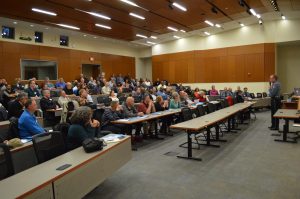Church security: Howard County Police stress vigilance, preparedness in houses of worship
A service at Holy Rosary Church in Baltimore, Maryland. Church security has become an important issue in houses of worship across America. (Anthony C. Hayes)
There was a time when those seeking solace in the solemn act of prayer could open the door of almost any house of worship – day or night. Times have changed, and mass shootings in Texas and South Carolina have underscored the fact that even the faithful need to set a watchman.
Preparedness was the homily last Thursday night at Howard Community College, where officers from the Howard County Police Department addressed the important issue of church security. The two-hour presentation was well received by about 120 people, representing a wide cross-section of congregations from Howard County and neighboring areas.

Gary Gardner, Chief of Police for Howard County, remarked in opening the presentation, “I’ve been with the department for over thirty years, and when I started, I never thought I’d be here tonight talking about an active shooter situation in a church.”
Gardner said the information being presented is important, but added, “It doesn’t end this evening. The department is here to work with you and your congregation.”
Leading the PowerPoint presentation were Cpl. A.C. Thomas, PFC Bonita Alecia, and PFC Steven Mitzel of the Howard County Police Department Community Outreach Section. The presentation was designed demonstrate the importance of drafting an emergency action plan.
Thomas talked about the history of church violence in America – beginning with Alabama’s 16th Street Baptist Church bombing in 1963 and concluding with the recent mass shooting in Sutherland Springs, Texas. Thomas also talked about two incidents closer to home: the 2012 shooting at St. Paul’s Episcopal Church in Ellicott City and the 2014 shooting at the Columbia Mall.
Thomas pointed out that, while statistically, the occurrences of church violence are very low, recent events have demonstrated they are increasing.
Addressing the civilian responses to an active shooter situation, Mitzel stressed the importance of maintaining a “survival mind set”.

“The average response time for law enforcement in an active shooter situation is approximately three minutes. But until we arrive, you are your own first responder. The survival mindset means you must decide to act and reassure yourself that you’re going to make it out alive,” said Mitzel.
Mitzel talked about the common sense aspects of running and hiding – focusing on securing safe spaces and leaving the area if the opportunity presents itself. But he also noted that playing dead is not a great idea and that people should be ready to fight for their lives with whatever implements they might find at hand.
Alicia brought up an important and often overlooked aspect of church security – the need to look after disabled members of the congregation in any sort of emergency.
“Can those members get out on their own or will they need help? This is another thing you must consider when developing your emergency plans.”
Along with the hand-outs, presentation, and offers of continued support by the Howard County Police and the Department of Homeland Security, each congregational leader was given a pin code number for a new preparedness App called Safeguarding Houses of Worship.
Safeguarding Houses of Worship is a tool for generating customized safety and security plans. Once completed, the App can help both congregants and emergency personnel react more efficiently in a crisis situation.
SHOULD CHURCH MEMBERS BE ARMED?
Closing out the program, Maj. E. A. Jones brought up what many consider to be a sticky subject: arming parishioners.

“How many of you have police officers or military members in your congregation?,” he asked.
At least seventy percent of the attendees raised their hands.
“I wear my weapon in church,” said Jones, “though I’m sure most of my fellow parishioners don’t know that. My guess is that most other law enforcement officers do the same thing. Police and military personnel are trained to be vigilant – they can be an invaluable asset in an emergency situation.”
Jones surprised some when he noted one group that church security planners should always employ – the little old ladies who act as greeters at the door.
“They know everybody and would be the first to see if something doesn’t look right or somebody doesn’t fit in.”
A short Q&A followed the presentation.
What did the audience think?
“I thought it was an excellent presentation,” said Bettye Ames – church council chair at Mt. Zion UMC in Highland: “It spoke to an issue we have been talking about in church council, so it was timely. Pastor Brantley was given the App access code, so you can be sure we will be following up with that aid.”

“Our job is to provide a place of hope,” said Pastor Tammi Brantley. “We have to make sure we are keeping our congregation and visitors safe. I think as pastors and clergy who are here to learn, we are continuing in the mission to provide hope in a safe environment.”
Mark Wigley, representing Countryside Fellowship Church in Savage, Maryland, said he too thought the presentation was helpful.
“They had a well-rounded approach on what should be done in the case of an event happening at your location. I’m fairly certain my congregation will be making use of some of the tools provided here this evening.”
Wigley also said he appreciated that Maj. Jones had carefully broached the subject of having fully trained armed church members at the ready.
“Some hate the idea of having people carrying fire arms to church. I get it! I’m not fond of that either and we would hope we could talk someone with bad intentions into giving their heart to Jesus. I haven’t heard that the poor folks at that church in Texas had the opportunity to do that.
“I understand there are a number of Scriptures that could speak to both sides of this issue of being armed or not. I keep going to Nehemiah 4:10-20 (a passage which talks about arming the men who were rebuilding Jerusalem.)

“I had a carry permit back in the late 90s but let it go when it expired. Next week I am beginning conceal carry classes. I’m not sure I’ll be granted a permit, but it’s the first step in a hard process to obtain a carry permit in one of the hardest States in the country.”
Father Constantine White, pastor of the Orthodox Church of St. Matthew in Columbia, was generous in praise for the program.
“I think we’ve learned a great deal – things I wouldn’t have imagined. We’re going to set up a committee and follow up with the Howard County Police Department. The fact that they have offered this service is really commendable. When the shooting happened recently in Texas, I thought, ‘What would we do?’ I had no clue.
“Our doors are open; the doors coming into the main body of the church are glass. How do you possibly protect a congregation? So I thought the information presented here tonight was very useful.
“Something which struck me, to my heart, was that one of the presenters said, ‘You’re the shepherds and you need to take care of your flocks.’ I need to do that – definitely.”
* * * * *
HOW TO RESPOND WHEN AN ACTIVE SHOOTER IS IN YOUR VICINITY
Quickly determine the most reasonable way to protect your own life. Remember that customers and clients are likely to follow the lead of employees and managers during an active shooter situation.
1. Evacuate
If there is an accessible escape path, attempt to evacuate the premises. Be sure to:
• Have an escape route and plan in mind
• Evacuate regardless of whether others agree to follow
• Leave your belongings behind
• Help others escape, if possible
• Prevent individuals from entering an area where the active shooter may be
• Keep your hands visible
• Follow the instructions of any police officers
• Do not attempt to move wounded people
• Call 911 when you are safe
2. Hide out
If evacuation is not possible, find a place to hide where the active shooter is less likely to find you. Your hiding place should:
• Be out of the active shooter’s view
• Provide protection if shots are fired in your direction (i.e., an office with a closed
and locked door)
• Not trap you or restrict your options for movement
To prevent an active shooter from entering your hiding place:
• Lock the door
• Blockade the door with heavy furniture
If the active shooter is nearby:
• Lock the door
• Silence your cell phone and/or pager
• Turn off any source of noise (i.e., radios, televisions)
• Hide behind large items (i.e., cabinets, desks)
• Remain quiet
If evacuation and hiding out are not possible:
• Remain calm
• Dial 911, if possible, to alert police to the active shooter’s location
• If you cannot speak, leave the line open and allow the dispatcher to listen
3. Take action against the active shooter
As a last resort, and only when your life is in imminent danger, attempt to
disrupt and/or incapacitate the active shooter by:
• Acting as aggressively as possible against him/her
• Throwing items and improvising weapons
• Yelling
• Committing to your actions
HOW TO RESPOND WHEN LAW ENFORCEMENT ARRIVES
Law enforcement’s purpose is to stop the active shooter as soon as possible. Officers will proceed directly to the area in which the last shots were heard.
• Officers usually arrive in teams of four (4)
• Officers may wear regular patrol uniforms or external bulletproof vests, Kevlar helmets,
and other tactical equipment
• Officers may be armed with rifles, shotguns, handguns
• Officers may use pepper spray or tear gas to control the situation
• Officers may shout commands, and may push individuals to the ground for their safety
How to react when law enforcement arrives:
• Remain calm, and follow officers’ instructions
• Put down any items in your hands (i.e., bags, jackets)
• Immediately raise hands and spread fingers
• Keep hands visible at all times
• Avoid making quick movements toward officers such as holding on to them for safety
• Avoid pointing, screaming and/or yelling
• Do not stop to ask officers for help or direction when evacuating, just proceed in the
direction from which officers are entering the premises
Information to provide to law enforcement or 911 operator:
• Location of the active shooter
• Number of shooters, if more than one
• Physical description of shooter/s
• Number and type of weapons held by the shooter/s
• Number of potential victims at the location
(Courtesy Department of Homeland Security)

Anthony C. Hayes is an actor, author, raconteur, rapscallion and bon vivant. A one-time newsboy for the Evening Sun and professional presence at the Washington Herald, Tony’s poetry, photography, humor, and prose have also been featured in Smile, Hon, You’re in Baltimore!, Destination Maryland, Magic Octopus Magazine, Los Angeles Post-Examiner, Voice of Baltimore, SmartCEO, Alvarez Fiction, and Tales of Blood and Roses. If you notice that his work has been purloined, please let him know. As the Good Book says, “Thou shalt not steal.”
